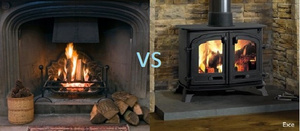A Guide to buying firewood
Things to consider
There are a number of factors to consider when buying firewood if you want to get the most for your money. Some of these are listed and explained below to help you buy the right wood for you and most of all help you stay warm.
Is a fireplace your only form of heating?
If so you will need more wood than a house that also uses a heat pumpWhat size is the room or house that you are heating?
A larger space will need more wood to heat it - take into account the height of the ceilings as well.How large is your firebox?
This will dictate the size of the firewood you can burn, we stock a range of differently sized woods to suit all needs.
How well insulated is your house?
A well-insulated house and double glazed windows help to retain the heat, meaning you should require less wood to heat your home.
Do you have an open fire or is it enclosed?
An open fire will lose a lot of heat straight up the chimney (as much as 70%) so you will need to burn more wood to get the same warmth as you would from a log burner. Also, there are certain woods to stay away from on open fires as they can spit and spark which can damage the floor around the fire and is a fire risk.How long will you be burning your fire for each day?
If you are burning your fire for long periods of time (most of the day) then you will want more hardwood as this puts out more heat than softwood and burns for longer (so no topping up the fire every 30 minutes). If you are only burning the fire in the evenings (or just a few hours a day) you will want closer to a 50/50 mix of hard to softwood.The different types of firewood
Different types of firewood? but wood is wood, right? Wrong, not all wood was created equal! There are two main types of wood, softwood, and hardwood.Softwood
- Is fast-growing and has a lower density
- Has a lesser ratio of heartwood to sapwood than hardwoods - heartwood gives more heat than sapwood when burnt
- Lower density woods are easier to light and start a fire with. It also is easier to split and lighter to handle
- Burns quicker than hardwood and doesnt give off as much heat
- Seasons quicker than hardwood but is more prone to taking moisture back on once dry
- Takes longer to grow than softwood
- Has a higher density
- Burns for longer and puts out more heat
- Takes longer to season but has more moisture resistance than softwoods
- Has a higher ratio of heartwood than softwoods
- Heavier and harder to split than softwoods
| Name | Type | Sparky | Burn Time | Burn Temp | Ideal Use |
|---|---|---|---|---|---|
| Pine | Softwood | No | Quick | Warm | Open fires/Starting a fire |
| Oregon | Softwood | A Little | Medium | Warm/Hot | Starting a fire and normal burning |
| Larch | Softwood | Yes | Medium/Long | Hot | Normal burning |
| Macrocarpa | Hardwood | Yes | Long | Hot | long periods of burning |
| Blue Gum | Hardwood | No | Very Long | Very Hot | Long periods of burning and high heat |
| Beech | Hardwood | No | Very long | Very Hot | Long periods of burning and high heat |
So what should I buy?
The average household during an average winter in Dunedin will use between 6-10 cubic meters of wood. We recommend burning hardwood as much as possible as this gives you more heat per log meaning you don't need to buy as much wood, you don't need to stack as much wood, and also you won't be topping the fire up every 10 minutes as it burns slower, so fewer trips to the woodpile on those cold winter nights.For a household that burns the fire most of the day a good ratio of hard/softwood (burning wood and starter wood) is 80/20 respectively. If you only burn your fire a few hours a day then you will want closer to a 50/50 mix of wood.

